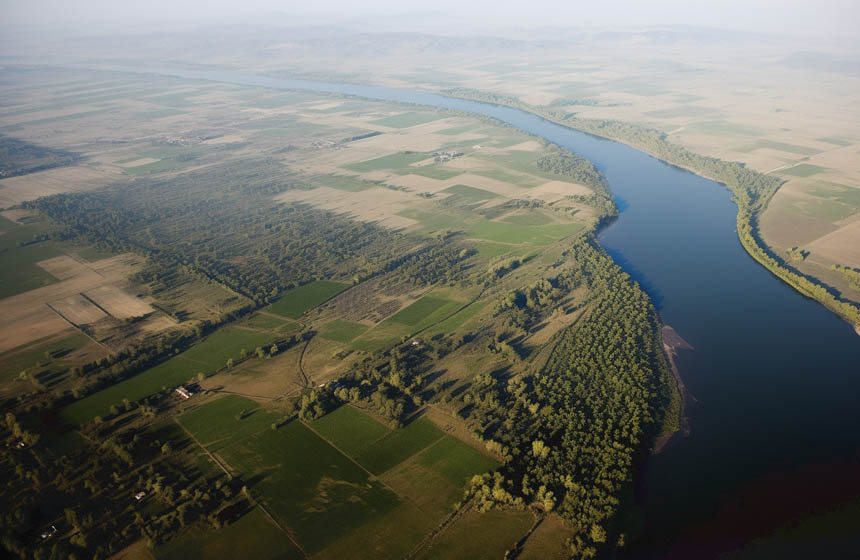Floodplain restoration for flood protection along the lower Danube river
The lower Danube green corridor project is a collaboration between Bulgaria, Romania, Ukraine and Moldova to create a green corridor along the entire 1,000+ km stretch of the lower Danube river in order to reduce the risk of major flooding events and bolster local economies.
Nature-based Intervention:
The lower Danube green corridor project was formed as an agreement between the governments of Bulgaria, Romania, Ukraine and Moldova to restore 224,000 hectares of floodplain as part of a broader green corridor which would include a preserved area of 935,000 hectares along the lower Danube river. As of 2020, more than 60,000 hectares of floodplains have been restored. Alongside this restoration there have been dike removals along the river to allow for it to resume its natural flow patterns and causing over 750 hectares of land to naturally return to a flooded state. Invasive plants were also an issue along the river, so investments were made to clear these plants and traditional cattle breeds were brought in to graze the invasive plants. Native vegetation was also planted along the corridor with tens of thousands of native trees planted along the river and areas created for natural forest regeneration.
Overview of context and outcomes:
The lower Danube river is an important regional river which has faced large scale degradation over the last century. The river had been cut-off from three quarters of its natural floodplains due to the construction of dikes which has lead to large changes in its flow course. This puts the region at greater risk as it is highly prone to flooding and this is likely to be exacerbated by climate change. Gravel extraction, dredging and dams construction along the river has also lead to lower water tables in nearby agricultural lands and the erosion of the riverbed. The river has also experienced high levels of eutrophication due to agricultural run-off.
Case effectiveness on
Climate change
Whilst no mitigation outcomes are reported, the large scale forest regeneration and tree planting programs likely lead to an increase in carbon sequestration.
The project has worked to reduce flood vulnerability faced by communities along the river by decommissioning under-performing flood protection dikes and restoring floodplains. These restored landscapes are reportedly a more successful mechanism of floodwater retention and allow for overall lower infrastructure maintenance costs. During the 2013 flooding event on the Danube river the lower Danube reportedly did not flood despite the higher than normal water levels. Th landscape reportedly also helps with drought management through holding and slowly releasing a larger volume of water.
Ecosystem health
Ecological effect: PositiveThe project has worked to improve habitat extent and habitat quality along the river. This is vitally important as there have been 5,137 species reportedly identified along this stretch of the river. The landscape is also reportedly a habitat for some of Europe’s rarest fish, such as the five species of sturgeon which call the river home. This includes the critically endangered beluga sturgeon(Huso huso) which travels up the river to spawn. This landscape is also vital for birds with 331 species utilizing river and 90% of the world’s Red-breasted geese(Branta ruficollis) living here. The restoration of natural river vegetation and restoration of the floodplain is also reportedly helping recharge groundwater resources and purify the water in the river.
Socioeconomic outcomes
The river is a highly important resource for the 29 million people which live in the basin. The improved river landscape reportedly had benefits for the collection of natural resources such as fish and reeds through the improved habitat quality. The landscape also reportedly generates €140,000 in tourism revenue annually. The community received increased flood protection which reportedly reduced the cost of environmental damages on nearby residents. The WWF estimates that the net value of the restored floodplain and river amounts to €111.8 million per year.
Governance
The World Wildlife Fund (WWF) Danube-Carpathian Programme has taken the lead on running this intergovernmental objective for restoring the river. The four countries in the agreement are the main implementers of the intervention, with the WWF taking a role as a facilitator to increase communication and cooperation.
Finance
The main funders of the project so far have been the WWF, national governments, EU and the business sector. The estimated cost of completing the entire restoration is 183 million euros.
Monitoring and evaluation
WWF Bulgaria has worked to design monitoring protocols for riparian forest restoration. Monitoring is also conducted to evaluate the conservation status of key species within the river system.
Trade-offs and limitations
No information yet available on tradeoffs.

Intervention type
- Restoration
Ecosystem type
- Streams, rivers, riparian
Climate change impacts addressed
- Drought
- Freshwater flooding
- Reduced water quality
Instigators
- International conservation/environment organization
- National government/agency
Societal challenges
- Biodiversity conservation
- Climate change adaptation
- Disaster risk reduction
- Economic and Social development
- Food security
- Water security
Outcomes
- Food security: Positive
- Water security: Positive
- Health: Not reported
- Local economics: Positive
- Livelihoods/goods/basic needs: Not reported
- Energy security: Not reported
- Disaster risk reduction: Positive
- Rights/empowerment/equality: Not reported
- Conflict and security: Positive
- No. developmental outcomes reported: 5
Resources
Read resource 1Read resource 2
Literature info
- Grey literature



